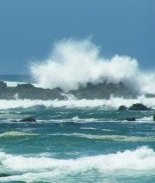CHANGES IN YELLOWFIN ABUNDANCE IN THE GULF OF TOMINI AND NORTH SULAWESI
C.P. Mathews, D. Monintja, Nurzali Naamin
ABSTRACT
C.P. Mathews, D. Monintja, Nurzali Naamin
ABSTRACT
Yellowfin tuna are taken on four Tomini Gulf (North Sulawesi) fishing grounds around "rakit"(small shallow-water fish aggregating devices) targeted towards scads and small yellowfin and around "rumpon" (larger deep-water fish aggregating devices) targeted towards medium-sized yellowfin. In Gorontalo, yellowfin landings increased from 1988 to a peak of more than 1,500 mt in 1990; the landings then declined steadily until 1995. Landings in Tilamuta, Paguat and Marisa fluctuated, but tended to peak between 100 and 200 mt around 1990. The CPUE at Gorontalo peaked in 1990 and fell markedly from 1990 onwards in all four fisheries; in 1995 the CPUE fell to about 30% of 1990 level in Gorontalo and to less than 10% of the 1990 levels at Tilamuta, Paguat, and Marisa. The sharp decline in CPUEs coincided with the extension of intensive offshore fishing by tuna longliners (mostly from Taiwan) and with the introduction of large-scale offshore industrial purse seining (which targets skipjack but also takes substantial amounts of yellowfin) by Philippine boats around North Sulawesi in 1990. The marked decline in yellowfin abundance suggests that offshore fishing impacted the Tomini Gulf fisheries.(fulltext ..>>)

